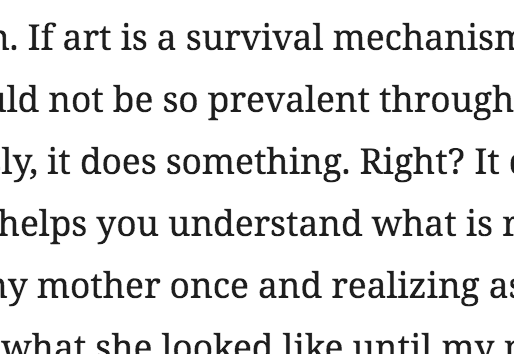
…Milton Glaser: Art serves a purpose even though very often one of the definitions of art in our time is that it has no purpose but I don’t agree with that. Well, so what could the purpose of art be if it is so universally present all through history and in every culture? Well, it must be it seems to me a device that aids human survival. Otherwise it would just fade away sometimes and reappear and come back but it’s always around. And then the question is okay, so how does it do that? Why should art be something that helps humans survive? How does it do that? It does that by making you attentive in the Buddhist sense, that it helps you understand what is real.
Milton Glaser: Well, I finally developed a field theory for the distinction which is my own. If art is a survival mechanism, which I think it is, otherwise it would not be so prevalent throughout human history, in every culture. Obviously, it does something. Right? It does something. Art makes you attentive; it helps you understand what is real, and I use the example of trying to draw my mother once and realizing as I looked at her at the age of 17 I had no idea what she looked like until my mind shifted in to its observing phase and I could see her at that moment more accurately than I had been able to see her before. Right? And when you walk by a forest if you have seen a Cezanne a day earlier you suddenly notice that the forest looks like what Cezanne has pointed out to you, that you were unable to see until he said, “Look at this and then go outside and look at the forest.” The real issue in art and everything else is understanding what is real and art helps us do that by making us attentive so the distinction between art is not whether it’s done on the canvas or whether it’s in a museum but whether it makes you attentive. And you will observe through your own experience that some art does not make you attentive in which case it’s not art, it’s something else, and some designs make you attentive in which case they are art. So that’s my field theory of the distinction between what is art and what is not.
Jo Reed: How is design different from art? Clearly, it encompasses art but it does other things too. Can you just…
Milton Glaser: Well, I finally developed a field theory for the distinction which is my own. If art is a survival mechanism, which I think it is, otherwise it would not be so prevalent throughout human history, in every culture. Obviously, it does something. Right? It does something. Art makes you attentive; it helps you understand what is real, and I use the example of trying to draw my mother once and realizing as I looked at her at the age of 17 I had no idea what she looked like until my mind shifted in to its observing phase and I could see her at that moment more accurately than I had been able to see her before. Right? And when you walk by a forest if you have seen a Cezanne a day earlier you suddenly notice that the forest looks like what Cezanne has pointed out to you, that you were unable to see until he said, “Look at this and then go outside and look at the forest.” The real issue in art and everything else is understanding what is real and art helps us do that by making us attentive so the distinction between art is not whether it’s done on the canvas or whether it’s in a museum but whether it makes you attentive. And you will observe through your own experience that some art does not make you attentive in which case it’s not art, it’s something else, and some designs make you attentive in which case they are art. So that’s my field theory of the distinction between what is art and what is not.
